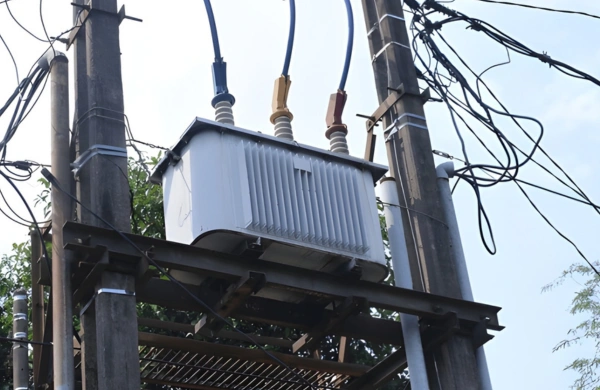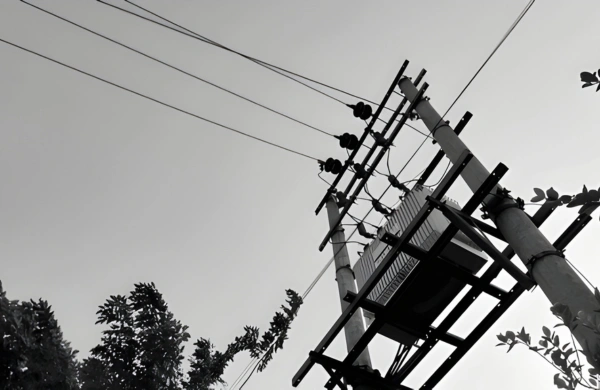Introduction
Efficient transmission of electrical power over long distances requires transforming generated voltage to higher levels with minimal loss. Step up transformers make this possible by increasing the voltage at generation points, reducing transmission current, and minimizing line losses. They play a critical role in ensuring that energy generated from power plants or renewable sources reaches consumers efficiently and safely.
Zetwerk designs and manufactures high-performance step up transformers built for reliability, low losses, and long service life. Engineered to comply with IEC, IEEE, and ANSI standards, Zetwerk’s transformers support utility substations, renewable energy projects, and industrial plants across North America — delivering proven performance for high-voltage power transmission systems.
Know About High-Efficiency Step Up Transformers for Transmission Networks
1. Role of Step Up Transformers in Power Transmission
When electricity is generated at power plants (typically 11–33 kV), it must be transmitted over long distances at high voltage to minimize losses. Step up transformers increase the voltage to transmission levels — often between 110 kV and 400 kV — allowing power to travel efficiently through transmission lines with reduced I²R (resistive) losses.
Primary applications include:
- Power generation stations: Stepping up generator voltage to grid transmission levels.
- Renewable energy plants: Converting low-voltage output from solar or wind inverters to grid-compatible levels.
- Industrial complexes: Feeding high-voltage distribution networks for large facilities.
- Grid interconnections: Enabling regional or cross-border power transfer.
Without step up transformers, power losses over distance would make large-scale electricity transmission economically and technically unfeasible.
2. Design and Construction of Step Up Transformers
Zetwerk’s step up transformers are engineered for maximum efficiency and durability, ensuring consistent voltage transformation under varying load conditions.
Core:
Constructed from grain-oriented silicon steel laminations or amorphous alloy, reducing core losses and magnetizing current. The core design minimizes noise and vibration while maintaining uniform flux distribution.
Windings:
High-conductivity copper or aluminum conductors with transposed strands to balance magnetic fields and minimize eddy current losses. Windings are insulated with high-grade paper, pressboard, or Nomex material for enhanced dielectric performance.
Insulation:
Zetwerk uses oil-impregnated paper (OIP) or resin-impregnated (RIP) insulation systems designed to handle high voltages up to 400 kV and beyond.
Tank and Enclosure:
Sealed steel tanks are built to withstand pressure variations, corrosion, and environmental exposure. For outdoor installations, tanks are equipped with conservators, pressure relief devices, and radiators for efficient cooling.
Cooling Systems:
Depending on power rating and environmental conditions, Zetwerk integrates ONAN (Oil Natural Air Natural), ONAF (Oil Natural Air Forced), OFAF (Oil Forced Air Forced), or OFWF (Oil Forced Water Forced) cooling systems.
3. Electrical Performance and Efficiency
Step up transformers operate continuously under high-voltage and thermal stress conditions. Zetwerk’s designs optimize efficiency, voltage regulation, and thermal management.
Typical performance parameters:
- Primary voltage: 11 kV to 33 kV
- Secondary voltage: 110 kV to 400 kV
- Power rating: Up to 400 MVA
- Efficiency: Above 99% at full load
- Voltage regulation: ±1.5% or better
- Insulation level: BIL up to 1,200 kV impulse withstand
- Thermal class: Class F (155°C) or H (180°C)
Each unit undergoes full-load testing to ensure minimal copper and core losses. Advanced design tools simulate electromagnetic flux, thermal gradients, and mechanical stress, ensuring optimized performance across all load conditions.
4. Testing and Compliance Standards
All Zetwerk transformers are type-tested and routine-tested in compliance with international standards.
Applicable standards:
- IEC 60076 – Power Transformers
- IEEE C57.12 – Standard for Electrical Power Transformers
- ANSI/IEEE C57.100 – Thermal Performance
- IEC 60060 – High-Voltage Testing
Key factory tests include:
- Turns ratio and polarity
- Winding resistance
- Insulation resistance
- No-load and load losses
- Temperature rise
- Impulse and partial discharge tests
- Short-circuit withstand capability
Testing ensures dielectric integrity, efficiency, and mechanical robustness before shipment. Each transformer is accompanied by a complete FAT (Factory Acceptance Test) report and compliance documentation.
5. Step Up Transformers in Renewable Energy Systems
With renewable energy generation expanding rapidly, step up transformers are becoming increasingly critical in connecting low-voltage generation to high-voltage transmission networks.
Applications include:
- Solar power plants: Stepping up inverter output (400–690 V) to 33 kV or higher.
- Wind farms: Converting generator voltage to grid levels (up to 132 kV).
- Hydropower stations: Adapting turbine generator voltage to match transmission systems.
Zetwerk designs specialized compact, oil-immersed, and cast resin transformers that meet the reliability, thermal, and environmental demands of renewable installations. Transformers can also be fitted with on-load tap changers (OLTCs) for dynamic voltage regulation.
6. Cooling and Thermal Management
Thermal control is essential for long transformer life. Overheating can degrade insulation, increase losses, and reduce operational efficiency.
Zetwerk employs advanced cooling solutions:
- ONAN: Passive oil and air circulation for small to medium ratings.
- ONAF: Forced air cooling for higher-capacity units.
- OFAF and OFWF: Active oil and water circulation for large transformers.
Temperature sensors and monitoring devices, such as PT100 sensors and oil-level indicators, ensure continuous thermal management and early fault detection.
All cooling systems are designed for low noise, ease of maintenance, and long-term field reliability.
7. Safety and Reliability Features
Safety and operational reliability are integral to Zetwerk’s transformer design philosophy.
Key safety features:
- Buchholz relay: Detects gas accumulation or insulation failure in oil-filled transformer
- Pressure relief devices: Prevent tank rupture under fault conditions.
- Oil-level and temperature gauges: Enable real-time monitoring.
- Conservator tanks with diaphragm seals: Maintain oil expansion and prevent oxidation.
- Anti-corrosive coatings: Provide protection against environmental degradation.
Zetwerk transformers are designed to meet seismic and environmental endurance requirements for long-term stability under harsh operating conditions.
8. Manufacturing Excellence and Quality Control
Zetwerk maintains complete manufacturing control — from raw material processing to final testing — ensuring precision and traceability.
Manufacturing highlights:
- CNC-controlled core cutting and stacking for high magnetic accuracy.
- Automated coil winding with precise tension control.
- Vacuum drying and oil impregnation for insulation stability.
- Dynamic balancing of windings to withstand short-circuit forces.
- Complete electrical and mechanical testing under simulated load.
Zetwerk’s transformer facilities operate under ISO 9001, ISO 14001, and ISO 45001 certifications, ensuring process quality, environmental responsibility, and worker safety.
9. Custom Engineering for North American Power Networks
Every grid system has unique requirements for voltage levels, tap settings, and installation environments. Zetwerk offers custom-engineered step up transformers designed specifically for North American standards and operational needs.
Capabilities include:
- Voltage customization up to 400 kV and 400 MVA.
- Tap changer configurations (OLTC or OCTC) for dynamic regulation.
- Dual-frequency (50/60 Hz) compatibility for cross-border projects.
- Modular skid or pad-mounted installations.
- Export documentation meeting UL, CSA, and IEEE requirements.
By combining precision engineering with flexible production capacity, Zetwerk delivers reliable, cost-efficient solutions tailored for transmission, renewable, and utility infrastructure.
10. Sustainability and Lifecycle Value
Zetwerk incorporates sustainable materials and designs that reduce energy loss and environmental impact throughout the transformer’s lifecycle.
Sustainability measures include:
- Low-loss CRGO and amorphous cores for improved efficiency.
- Eco-friendly ester oils as an alternative to mineral oil.
- Recyclable metals and components for end-of-life recovery.
- Optimized designs for minimal maintenance and long service intervals.
These practices support North American utilities and EPCs in meeting ESG goals and long-term cost optimization objectives.
Conclusion
Step up transformers are critical to global energy infrastructure, enabling efficient transmission from generation points to distribution networks. Their reliability defines the stability and efficiency of power systems.
Zetwerk manufactures high-efficiency step up transformers engineered for grid-scale performance, long operational life, and thermal stability. Each unit undergoes comprehensive testing to guarantee performance under demanding electrical and environmental conditions.
With world-class design, manufacturing control, and adherence to international standards, Zetwerk ensures dependable transformer solutions that power North America’s evolving energy landscape — from traditional power stations to renewable generation hubs.




FAQs
a. It increases the voltage from generation level (e.g., 11 kV) to higher transmission levels (e.g., 132–400 kV) to reduce losses.
a. They are used in power plants, substations, renewable energy farms, and industrial grids.
a. ONAN, ONAF, OFAF, and OFWF systems are available based on power rating and site conditions.
a. All units comply with IEC 60076, IEEE C57.12, and ANSI standards.
a. Yes. Zetwerk provides custom voltage, tap changer, and insulation configurations for North American utilities and EPC projects.








